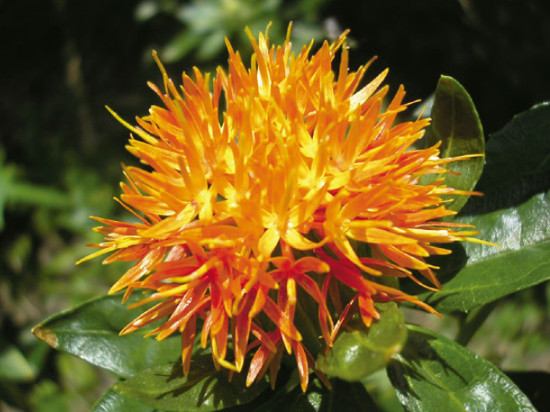Allelopathic effects of jack bean leaf aqueous extract on safflower cultures

Abstract
This study verified the allelopathic influence of jack bean leaves (Canavalia ensiformis) on safflower cultures (Carthamus tinctorius), applied at different concentrations. Ten safflower genotypes were seeded in 20 containers, and a concentrate was prepared with jack bean leaves, crushed with water to make the extract. Five treatments were performed with four replicates, and this extract was applied at concentrations of 0%, 25%, 50%, 75% and 100%. The parameters were germination speed, percentage of germination, dry and fresh mass, leaf and root size. The jack beans influenced each evaluated treatment differently, presenting, at some times, neutral characteristics, inhibitory characteristics, or stimulating characteristics, varying according to the percentage of extract that was applied.Keywords
Canavalia ensiformis, Carthamus tinctorius, sowing, germination, growth, development.
References
- Anaya, A.L. 1999. Allelopathy as a tool in the management of biotic resource in agroecosystems. Crit. Rev. Plant Sci. 18(6), 697-738. Doi: https://doi.org/10.1080/07352689991309450
- Beiguelman, B. 2002. Curso prático de bioestatística. 5ª ed. FUNPEC Editora, Ribeirão Preto, Brazil.
- Corrêa, M.P. 1974. Dicionário das plantas úteis do Brasil e exóticas cultivadas. Ministério da Agricultura, Rio de Janeiro, Brazil.
- Costa, J.C.G. and M.J.O. Zimmermann. 1998. Melhoramento genético. pp. 229-245. In: Zimmermann, M.J.O., M. Rocha, and T.E.U. Yamada (eds.). A cultura do feijoeiro: fatores que afetam a produtividade. Potafós, Piracicaba, Brazil.
- Dudai, N., A. Poljakoff-Mayber, A.M. Mayer, E. Putievsky, and H.R. Lerner. 1999. Essencial oils as allelochemicals and their potential use as bioherbicides. J. Chem. Ecol. 25(5) 1079-1089. Doi. https://doi.org/10.1023/A:1020881825669
- Freitas, M.C. 2004. Efeito alelopático de leguminosas como adubos verdes sobre a germinação e emergência de plantas daninhas. Trabalho de conclusão de curso. Unicastelo, Fernandópolis, Brazil.
- Gerhardt, I.F.S. 2012. Devergência genética entre acessos de cártamo. Botucatu 1, 1-35.
- Harper, J.R. and N.E. Balke. 1981. Characterization of the inhibition of k+ absorption in oat roots by salicylic acid. Plant Physiol. 8(6), 1349-1353. Doi: https://doi.org/10.1104/pp.68.6.1349
- Kato-Noguchi, H., S. Kosemura, S. Yamamura, J. Mizutani, and K. Hasegawa. 1994. Allelopathy of oats. I. Assessment of allelopathic potential of extract of oat shoots and identification of an allelochemical. J. Chem. Ecol. 20(2), 309-314. Doi: https://doi.org/10.1007/BF02064439
- Khalid, N. and R.S. Khan. 2017. A comprehensive characterization of safflower oil for its potential applications. Trends Food Sci. Technol. 66, 176-186. Doi: https://doi.org/10.1016/j.tifs.2017.06.009
- King, S.R. and R. Ambika. 2002. Allelopathic plants. 5. Chromolaen odorata (L.). Allelopath. J. 9(1), 35-41.
- Luckner, M. 1990. Secondary metabolism in microorganisms, plants, and animals. Gustav Fischer Verlag, Jena, Germany. Doi: https://doi.org/10.1007/978-3-662-09838-7
- Magalhães, A.C. and C.M. Franco. 1962. Toxicidade do feijão-de-porco sobre tiririca. Bragantia 21, 53-57. Doi: https://doi.org/10.1590/S0006-87051962000100064
- Maguire, J.D. 1962. Speeds of germination-aid selection and evaluation for seedling emergence and vigor. Crop Sci. 2, 176-177. Doi: https://doi.org/10.2135/cropsci1962.0011183X000200020033x
- Mendonça, R. 2008. Lourenço de determinação de aleloquímicos por HPLC/UV-Vis em extratos aquosos de sementes de Canavalia ensiformes e estudo da atividade alelopática. M.Sc thesis. Instituto de Química de São Carlos, Universidade de São Paulo, São Carlos, Brazil.
- Molisch, H. 1937. Der Einfluss einer Pflanze auf die andere Allelopathie. Gustav Fischer Verlag, Jena, Germany.
- Nery, M.C., M.L.M. Carvalho, F.C. Nery, and R.M.O. Pires. 2013. Potencial alelopático de Raphanus sativus L. var. oleiferus. Abrates 23(1), 15-19.
- Putnam, A.R. and C. Tang. 1986. The science of allelopathy. Wiley, New York, USA.
- Rice, E.L. 1984. Allelopathy. 2th ed. Academic Press, New York, USA.
- Rodrigues, J.E.L.F., R.N.B. Alves, O.M.N. Lopes, R.N.G. Teixeira, and E.S. Rosa. 2004. A Importância do feijão-de-porco (Canavalia ensiformis DC) como cultura intercalar em rotação com milho e feijão caupi em cultivo de coqueirais no município de Ponta-de-Pedras/Marajó-PA. Technical statement No. 96. Embrapa Amazônia Oriental, Brasília, Brazil.
- Santos, S., M.L.L. Moraes, A.P.S. Souza Filho, and M.O.O. Rezende. 2005. Allelopathic potential and systematic evaluation of organic extracts from Canavalia ensiformis leaves (Jack beans). J. Environ. Sci. Health B 40(1), 77-84. Doi: https://doi.org/10.1081/PFC-200034234
- Santos, R.F. and M.A. Silva. 2015. Carthamus tinctorius L.: Uma alternativa de cultivo para o Brasil. Acta Iguazu 4(1), 26-35.
- Souza Filho, A.P.S. and S.M. Alves. 1998. Alelopatia em ecossistemas de pastagens cultivadas. Documents No. 109. Embrapa-Cpatu, Belém, Brazil.
- Smith, A.E. 1989. The potential allelopathic characteristics of bitter sneezeweed (Helenium amarum). Weed Sci. 37(5) 665-669.
- Stefanello, R., L.A.S. Neves, M.A.B. Abbad, and B.B. Vianna. 2016. Potencial alelopático de extratos de chia na germinação e no vigor de sementes de rabanete. Rev. Cultiv. Saber 9(1), 11-23.
- Tur, C.M., J. Borella, and L.H. Pastorini. 2010. Alelopatia de extratos aquosos de Duranta Repens sobre a germinação e o crescimento inicial de Lactuca sativa e Lycopersicum esculentum. Biotemas 23(2), 13-22.
Downloads
Download data is not yet available.
